
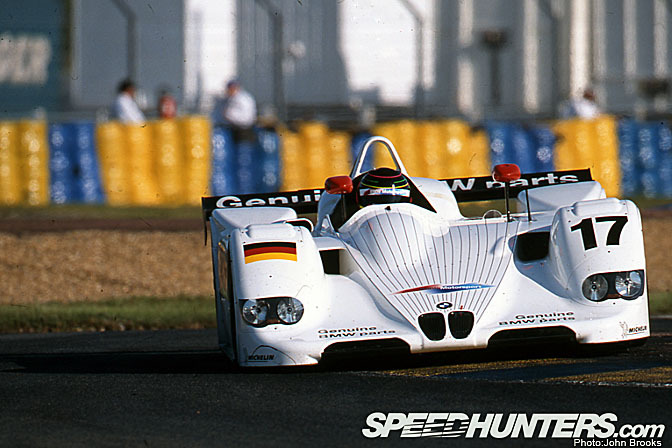
There are times when the features that I write for SpeedHunters develop a life of their own. In this case what started out as a quick look at the BMW V12 LMR’s victory at Le Mans back in 1999 has turned into something a little bigger than that. The events from that week in June 1999 still echo around racing today in physical and commercial terms and looking back has brought me face to face with those issues. One thing that is certain, it is doubtful that we will ever see the 1999 scale of manufacturer involvement repeated at La Sarthe, which may not be all bad……………………..

So starting out at 7.00pm on the Wednesday with the commencement of Qualifying the BMW squad would have been quietly confident, they may not have had the absolute speed of the Toyotas or even Mercedes but the package as a whole was stronger, without some of the other teams’ apparent weaknesses, over 24 hours they should be able to do the business.

Almost immediately one of their rivals hit trouble, big time. A sticking throttle pitched one of the Nissan R391s into and nearly through the armco at Terte Rouge. The session was red flagged while the injured driver, Eric van de Poele, was extracted and hospitalised. The news that he had suffered fractured vertebrae but would eventually make a full recovery was sobering through the paddock. This race was serious. The accident took the wind out of Nissan’s sails and they were not a feature in the battle for supremacy.

Back on track, things settled down to normal and, as predicted, Toyota took initial honours with Martin Brundle scorching round in 3:29.930, the first sub 3:30 lap since Group C days. The German-Japanese team would also have been pleased to see Thierry Boutsen wrap up the front row with the second GT-ONE just under a second slower than the Englishman. Furthermore they would have been puzzled but happy the slowish pace of the Mercedes, over 5 seconds back, but concerned at the speed of the BMWs.
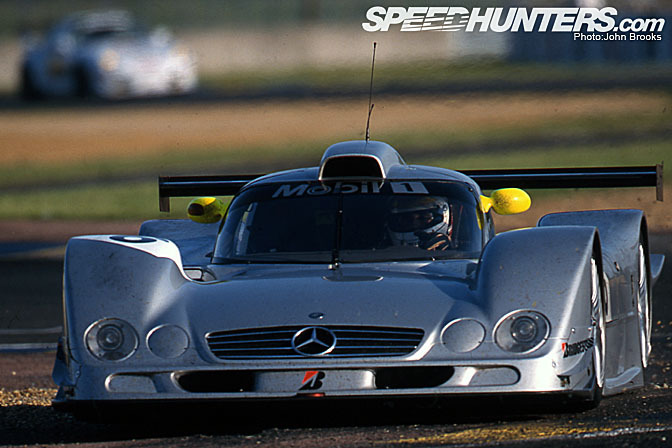
24 Hours later and everyone was back on track with Bernd Schneider absolutely wringing the neck out of the CLR trying to scramble up the grid. Then came the next drama, this time involving Mercedes.
Mark Webbers’ CLR had apparently become airborne on the way down to Indianapolis, the fastest section of the circuit, almost flipping and eventually landing back on its wheels. At a hastily convened press conference excuses were made and reasons given, but much was shrouded in mystery as there had been no TV footage nor press at the site to confirm or deny the official line. The two things that were known for certain was that Webber was OK and that the car would run again in the Saturday morning warm up.

And so he did………….but Webber did not complete a lap, once again taking to the skies, this time on the approach to Mulsanne Corner with photographers’ cameras rolling and the TV coverage picking up the aftermath.

Webber was once again shaken but otherwise unhurt, this time the car was out of the race……..and surely so were the other two CLRs…………

No it appeared that was not the case. After consulting with the drivers and engineers, and adding front splitters and making other aerodynamic adjustments to the CLR, Dr. Hubbert, President of Daimler-Chrysler, announced to the world that the cars would start the race.

It was a relief to get the race underway with Brundle and Boutsen in the Toyotas leading the way from the pack. Kristensen and Dalmas in the BMW V12 LMRs being part of the chasing group of cars. All running to schedule.

Dalmas’ BMW pressured his countryman Bouchut’s Mercedes in the scrap over 5th place, just behind the leaders.

The Mercedes of Schneider jumped the Toyotas at the first pit stops and at the time it was assumed that this was due to superior pitwork. McNish later explained to me that the GT-ONE had a very long first gear and that contributed to the poor re-starts. The cycle of time gained on the track being frittered away in the pits was beginning to heighten the already highly pressured situation for the drivers.
Of greater concern to both Toyota and Mercedes was the ability of the BMWs to run an extra lap and still maintain contact with the marginally faster trio. Over time this would translate into two or three less stops, a huge potential advantage. It was clear that the race was swinging towards Munich. However there were some 23 hours to go.

As early as the second hour, the Muller BMW slipped into the lead, with the Toyota of McNish and the Mercedes of Lamy in close pursuit. Just adrift of this trio was Collard’s GT-ONE with the Martini V12 LMR and Heidfeld’s CLR all engaged in a big scrap. With fuel advantage up their sleeves, BMW looked stronger and stronger.
McNish forced the lead Toyota past the BMW setting a new lap record in the process but he could not shake off the German and once again lost his advantage when he pitted. Muller back in front.

Just before 9.00pm came the incident that would launch millions of YouTube views. Peter Dumbreck’s Mercedes took off on the approach to Indianapolis, almost at the same place theat Webber had gone over on Thursday evening. This time the car vaulted the armco, landing in the trees, on a piece of ground that had recently been cleared, I was told later that a tree stump had punched its way into the chassis, between the driver’s seat and the fuel tank…………..
Not only had the CLR flown but the whole incident was captured on live TV. I was on my way through the tunnel that connects the pits with the ACO building when I was nearly flattened by a Mercedes TV crew running back to the pits… I followed and there on the big screens was the flying CLR. The crowd, indeed the whole pit lane, was stunned into silence.
Dumbreck was thankfully unhurt, but as the accident had happened on a stretch of public road I was told that the Gendarmerie breathalysed him…………
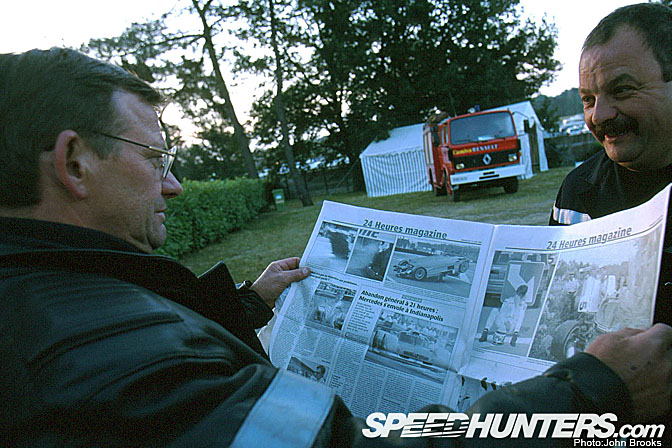
The incident was subsequently splashed on the news everywhere.
The other car was immediately withdrawn. It was the end of Mercedes Benz and Le Mans, Dr Hubbert declared that the company would never return.

As night fell, the race was headed alternatively by the BMW and the two Toyotas, TK beaking McNish’s lap record in the process. Time and again any advantages the red and white cars made on the road were lost in the pit stops, and there was also the prospect of the BMW’s better fuel economy coming into play. Then the fates turned against Toyota. Martin Brundle’s car first suffered a gearbox problem that cost the car 10 laps and then striving to make up time Brundle had a massive accident while braking for the first chicane down the Mulsanne Straight. A punctured tyre at over 300kmph robbed him of any prospect of controlling the car and it slammed into the barriers wrecking the rear. He managed to get the striken GT-ONE round as far as Arnage but was forced to concede and retired on the spot.

As if that was not enough just after 3.00am on the Sunday, Thierry Boutsen’s Toyota collided with a backmarker Porsche. The GT-One hit the retaining wall on the entry to the Dunlop Chicane, another high speed location, wrecking the car and leaving the Belgian trapped in the car. He was extracted from the cockpit and whisked off to hospital, having fractured his second vertebrae. The crash ended this career of the popular ex-Formula One star, a three-time Grand Prix winner. BMW looked unstoppable.

With Mercedes gone and two of three Toyotas also out, dawn broke to see BMW running 1-2, there being a three lap lead for the 17 car. The only potential challenger was the final Toyota clinging onto the same lap as the 15 car.

Then disaster hit the leader. With JJ Lehto at the wheel a suspension component failed and wedged the throttle open just at the entry to the Porsche Curves. Two heavy impacts were suffered by the V12 LMR and the car that had led for 269 laps was out on the spot. JJ suffered minor leg injuries but the loss of a near certain win hurt a great deal more.

With four hours to go, there was now only two and a half minutes between the surviving BMW and Toyota, so a sprint to the finish was in prospect.

The 15 BMW had been in the shadow of the superfast sister car but had run round reliably, the only real problem it had during the race was an early morning spin by Winkelhock but aside from blushes from “Smokin’ Jo” no damage was done and the car was on its way losing little time.

With all the retirements, the Audi R8R was now up to third.
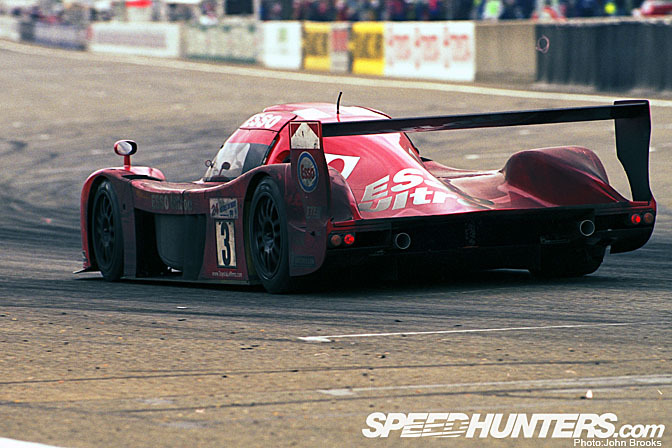
The race had began as a flat out sprint and was going to end that way too. The Toyota of Ukyo Katayama really was putting pressure on Martini in the BMW, the gap was less than two minutes. The Japanese driver posted a new lap record in the chase of the Italian, it was really too close to call, the final mistake would decide the race.

With just under an hour to go the final twist in the plot unfolded with Katayama’s right rear tyre failed at speed on the approach to Indianapolis. He managed to keep the car out of the wall but the crawl back to the pits for a replacement tyre cost over four minutes and with that, the race.

So surrounded by the usual scenes of high emotion that mark the finish of a 24 Hour race, particularly Le Mans, Pier-Luigi Martini crossed the line and took the flag waved by the race director, Marcel Martin.
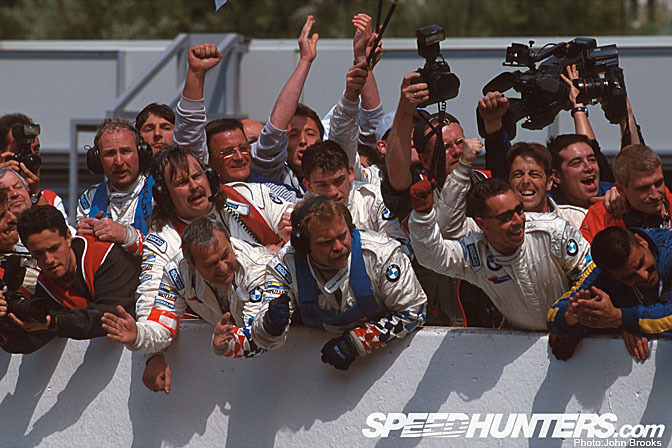
The Schnitzer Team were delighted and would celebrate in the traditional Bavarian manner. The number 15 ran a pretty faultless race and only spent 33 minutes in the pits, a tribute to the hard working team.

To add to BMW’s day, Thomas Bscher brought his BMW V12 LM98 across the line in fifth place, first privateer home. This result went some way to make up for the failure of the car in the hands of the factory some 12 months earlier.
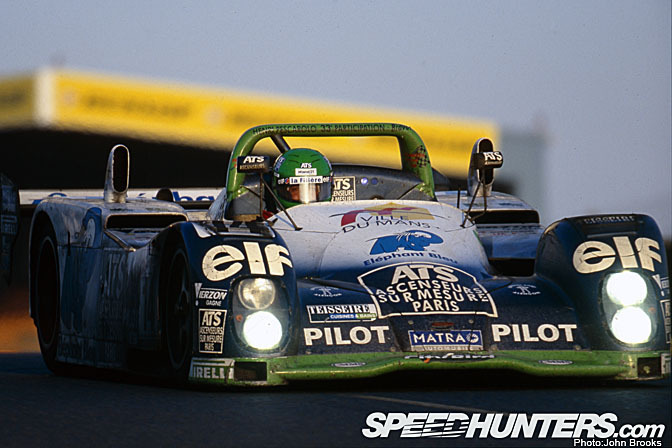
Also a finisher, down in 9th was the great Henri Prescarolo. Henri, a winner four times, was competing in his 33rd and final Les Vingt Quatre Hueres du Mans, at least as a driver. This is a record of participations in the great race that is unlikely to ever be exceeded.
Salut Henri.

In the final analysis BMW were deserved winners of the 1999 Le Mans 24 Hours. They had applied engineering excellence, motor racing nous and sheer hard graft to solve a problem that had and has eluded others. The victory was achieved against the strongest opposition imaginable and little was left to chance. It is a pity that they chose to leave the arena and hitch their wagon to the Formula One circus. Imagine the past years with Audi and BMW going hammer and tongs with each other every June, it would have been the stuff that legends are made of, with a great deal more meaning to their potential customer base than racing in the sands of Abu Dhabi or some similar outpost of motorsport.
A missed opportunity after such a great triumph.
-John Brooks






I saw the CLR flip that day on TV, it was a weird noiseless few seconds, then everyone realised that we were watching something historic, @John, do u think Mercedes will ever run a LeMans program again?..Thought Toyota had a chance that year too, but after the first 2 hrs we knew BMW had a superior machine, great write up!!!
http://video.google.com/videoplay?docid=-1252498464502394753#
Kinda funny how his last name is "Dumbreck" and so his nickname became "Lucky Dumbreck" after that flip as in Lucky (DUMB WRECK).
Great story and photos. Well earned win for BMW and I'm a Toyota fan. It would have been great if Toyota and Keiichi Tsuchiya won in the GT-One. I thought the CLR was the best looking car that year on the grid...so hopefully Mercedes return to LeMans again.
Awesome pics and writeup. Cheers.
Ripper of a stunner of a post John. I used your LMR shots from SCP as desktop backgrounds for about two years on my last work computer in NZ...
Thanks once again for the kind comments.
Mercedes and Le Mans???? Not at present, MB are buying into F1 in a big way, now they are supposed to take a chunk of Brawn.........as well as their 40% share in McLaren, plus supplying engines to Red Bull and Force India.
They have their domestic marketing covered with DTM, which they jointly control with Audi, so I cannot see any incentive to take on another programme such as Le Mans.
Also they have been very careful to airbrush the events of LM 1999 from history............no point in waking that sleeping dog.
jb
Didn't a few Porsche 917s, one helmed by Mark Donohue, take to the air along Road Atlanta's back straight during Can Am shakedowns? While those efforts eventually produced the Panzer (which many blame for the series' demise), I can't help but view the Mercedes Benz withdrawal from future Le Mans as an overreaction and a waste.
They probably should have left in 1999 after the second CLR launched, but why vow never to return? Was MB already looking to F1 (Brooks mentions Toyota and BMW moving to F1 as a (the?) contributing factor in the demise of their respective Le Mans efforts, but makes no mention of F1 with respect to MB)? There must be more substance behind MB's complete withdrawal than the CLR's aero problems. Neither can superstition left over from 1955 be considered reasonable, given MB's corporate composure and motorsport history. Perhaps they too were angry with the fledgling regulations? Even that isn't credible, as they benefitted from those regs (IIRC, they were able to fit the requisite suitcase in an empty fuel tank during scrutineering) and certainly had help power over the ACO, especially as part of a disgruntled manufacturers bloc.
So what gives, other than perhaps a petulant CEO?
BTW, excellent insights and an immersive series of articles (as always), Mr. Brooks.
regards,
Henk
When contemplating our lives, personally and professionally, there are areas that all of us prefer not
Even for those of us getting on a bit, ten years, a whole decade, is a significant chunk of time. Ten